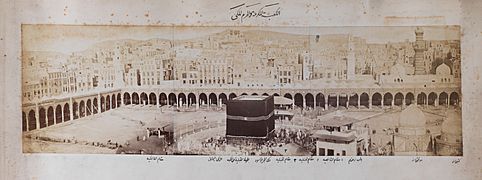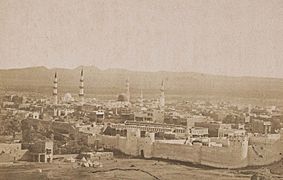Muhammad Sadiq (photographer) facts for kids
Quick facts for kids
Muhammad Sadiq
|
|
|---|---|
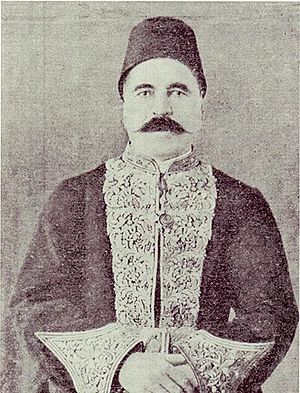 |
|
| Born | 1822 or 1832 |
| Died | 1902 (aged 79–80 or 69–70) |
| Occupation | military surveyor, photographer, author |
Muhammad Sadiq Bey (1822 or 1832 – 1902) was an Ottoman Egyptian army engineer and surveyor who served as treasurer of the Hajj pilgrim caravan. As a photographer and author, he documented the holy sites of Islam at Mecca and Medina, taking the first ever photographs in what is now Saudi Arabia.
Contents
Life and career
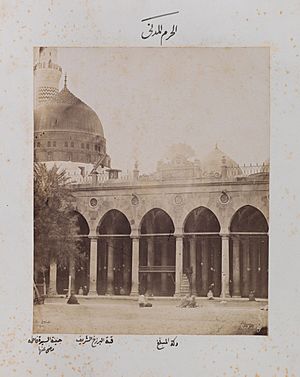
Born in Cairo, Sadiq was educated in Cairo's military college and at the Paris École Polytechnique. He qualified as an colonel in the Egyptian army and returned to the military college to teach cartographic drawing.
In 1861, he was assigned to visit the region of Arabia from Medina to the port of Al Wajh and conduct a detailed survey. He took a small team and some surveying equipment as well as his own camera; photography was not part of the official mission. His records of the expedition are the earliest known detailed accounts of the region's climate and settlements. His photographs of Medina were the first ever taken there. In 1880 he was assigned to accompany the Hajj pilgrim caravan from Egypt to Mecca as its treasurer. He was responsible for the safe passage of the mahmal, a ceremonial passenger-less litter, to Mecca. Again he brought a camera, becoming the first person to photograph Mecca, the Great Mosque, the Kaaba, and pilgrim camps at Mina and Arafat.
In the 1870s he was given the title Bey and two decades later the higher rank of Pasha. By the end of his military career he reached the rank of liwa, equivalent to Major-General. He was briefly the governor of the Egyptian city of Arish but returned to Cairo after suffering sunstroke. He was married for 34 years; his wife died while accompanying him on a trip to Medina and is buried there. Sadiq died in Cairo in 1902.
Photographs
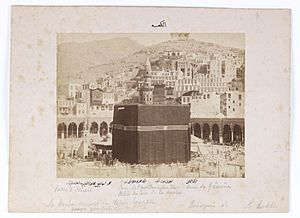
Sadiq used a wet-plate collodion camera, which had been invented in the 1850s. This produced negatives on wet glass plates, requiring a portable darkroom. From these negatives he made albumen prints which he signed or, later, stamped.
The sanctuaries of Mecca and Medina are the holiest sites of Islam. As part of the Hajj which is one of the five pillars of Islam, pilgrims perform rituals at Mecca and other nearby sites. On his expeditions from 1861 to 1881, Sadiq photographed the interiors and exteriors of sites on the Hajj pilgrimage route as well as at Medina. Photographing the Al-Masjid an-Nabawi (Prophet's Mosque) and its surroundings in Medina on 11 February 1861, he noted in his diary that no-one had taken such photographs before.
He used walls and mosque roofs as vantage points to capture panoramas of the cities. He also photographed people connected to the holy sites. As well as the Hajj pilgrims walking around the Kaaba, he photographed Shaykh 'Umar al-Shaibi, the keeper of the key of the Kaaba, and Sharif Shawkat Pasha, guardian of the Prophet's Mosque.
In 1876 his photographs of Medina were displayed at the Centennial Exposition in Philadelphia. He presented an album of twelve photographs at the 1881 Third International Conference of Geographers in Venice, winning a gold medal. As a result, this set was published as Collection de Vues Photographiques de La Mecque et de Médine.
His photographs are held today by collections including the Khalili Collection of Hajj and the Arts of Pilgrimage, the Victoria and Albert Museum, the Reiss Engelhorn Museum, and the Harvard Fine Arts Library. The curator Claude Sui describes Sadiq's achievements in photography as very significant: "[T]he sheer quality of his photographs is evidence of his talent in this field and reveals professional standards in his handling of the wet collodion procedure". His photography reflects both a cartographer's awareness of spatial relationships and a devout Muslim's connection to the region, culture, and people.
Gallery
-
A general view of Medina, including the Al-Masjid an-Nabawi and its Green Dome
See also
- Christiaan Snouck Hurgronje, first European to photograph Mecca


